#Imperial Library of the Louvre
Explore tagged Tumblr posts
Text

Imperial Library of the Louvre
1857
Édouard Baldus
#dark academia#light academia#classical#academia aesthetic#escapism#academia#books and libraries#classic literature#books#architecture#art#Imperial Library of the Louvre#artist#Édouard Baldus#1800s#19th century#royal core#cottage core#aesthetic#aesthetics#academic#artistic#mood#vibe#tumbrl
170 notes
·
View notes
Text
Optimus princeps

Marcus Ulpius Trajan was born on 18 September 53 in Hispania Baetica ( Andalusia, Spain) in the ancient city Italica. He stood out for his military and political brilliance, his uprightness and fight against corruption, his austere character, and his philanthropy.
He was the only Roman emperor to be granted the title Optimus (The Best) .Such a title was an extraordinary honor not so much because of the meaning of the word but because it was the exclusive title of the god Jupiter.
With Trajan began the so-called Golden Age of the Roman Empire, and the so-called era of provincial emperors. Roman authors note his "charming provincial accent." The historian Dio Cassius claims that Trajan was of Hispanic origin.
Trajan created Institutio Alimentaria, a program that helped orphaned and poor children throughout the Roman Empire. It provided food and subsidized education.
He conquered Dacia (Roman Dacia would evolve over time to give rise to present-day Romania) and defeated the Parthian Empire by conquering vast territories. During his reign the Roman Empire reached its maximum extension, setting its eastern border on the Tigris River and not on the Euphrates as it was before Trajan.
Trajan is mentioned in The Romanian National Anthem. In Romania the name TRAIAN is very common. He was the last conqueror of Rome; his successor Hadrian marked the definitive borders of the empire.
"Be more fortunate than Augustus and better than Trajan" It became the greeting to emperors

Trajan spent his childhood during the reign of Nero. At the age of 15 he experienced the first civil war of the imperial era and the year of the 4 emperors. He made a career in the army under the principate of Vespasian and his sons Titus and Domitian; Was close and loyal to the Flavian Dynasty.
Following the assassination of Domitian in September 96, Nerva was proclaimed emperor. In 97 a revolt by members of the Praetorian Guard forced the elderly and childless Nerva to adopt as his successor the popular Trajan, then governor of Germania Superior.
Nerva died on 28 January 98 and Trajan succeeded him. One of his first acts was the construction of a limes to secure the Decuman Fields, Germanic lands on the right side of the Rhine, which had been won under Domitian.
Trajan arrived in Rome two years after being proclaimed emperor, having secured the Rhenish frontier. He was received with great joy.

Trajan's Forum in Rome was built by the architect Apollodorus of Damascus, chosen by Trajan himself. It included a basilica, two libraries, and after Trajan's death, a temple was built in his honour. Trajan's Column is the only structure that has survived.


The column was inaugurated on May 12, 113 and consists of a long spiral frieze describing the Dacian Wars (101-106)

The Alcántara Bridge, Extremadura, Spain, widely regarded as a masterpiece of Roman engineering, was built during the reign of Trajan. Photo: Dantla from de.wikipedia - Own work, GFDL

His wife, empress Plotina. Photo: Carole Raddato.
Trajan was married to Plotina, who according to Pliny the Younger "Added to Trajan's virtues of modesty and nobility of spirit her own, for she was kind, intellectual and benevolent."
He married her at a very young age, and she was his only wife. It is believed that they had no children because they never had sexual intimacy. They always had a cordial relationship.
Trajan adored his niece Matidia, daughter of his only sister Marciana. In fact, everyone saw her as a daughter of the emperor rather than a niece. Empress Plotina also loved Matidia as a daughter. Matidia and his mother Marciana lived with Trajan and Plotina since Matidia was a little girl when her father died. All classical sources also claim that Plotina and Marciana loved each other like sisters.

His niece, Matidia. Photo: Louvre Museum , CC BY-SA 3.0, via Wikimedia Commons
Trajan's niece, MATIDIA, is key to understanding how the so-called "adoptive emperors", with the exception of Nerva, were related to each other by ties of blood and marriage, and not as the false modern version tells us of the emperors who did not think about family ties when choosing their successors until Marcus Aurelius "broke the good tradition" naming his son Commodus as successor ( It was really shocking to have heard such misinformation in a certain documentary series).
Trajan chose as his successor Hadrian, his second-degree nephew and only male relative, who was married to Vibia Sabina, one of Matidia's daughters. From Trajan's other great-niece, Rupilia, were directly descended the Emperor Marcus Aurelius and the Empresses Faustina the Elder, wife of Emperor Antoninus Pius (Hadrian's successor) and Faustina the Younger, wife and cousin of Marcus Aurelius, as well as the co-Empress Lucilla, married to Marcus Aurelius's co-Emperor Lucius Verus, and the Emperor Commodus.

Map in Latin. Roman empire in the year 117 when Trajan died.
Trajan died of illness between 8 / 9 August 117 in Selinus (Cilicia). His wife placed the gold urn containing his ashes on Trajan's Column. He was deified by the Senate.

Trajan's Column, Rome. Photo: Nikon Z7II, CC BY-SA 4.0, via Wikimedia Commons
The Trajan's Column was an absolute novelty in ancient art and became the most avant-garde work of Roman historical relief.
81 notes
·
View notes
Text



Vénus Accroupie (Louvre)
Vénus de Vienne (Musée du Louvre)
Lely Venus (Sir Peter Lely British Museum)
Roman copy of the Imperial era (Antonine period 2nd c. AD). Marble approx H. 1.12 m (3 ft. 8 in.) After a Hellenistic original by Doidalses of Bithynia
https://en.wikipedia.org/wiki/Lely_Venus
https://art.rmngp.fr/fr/library/artworks/aphrodite-accroupie-dite-venus-de-vienne_sculpture-technique_marbre
https://en.wikipedia.org/wiki/Crouching_Venus
#Lely Venus#Venus#crouching#roman#marble#copy#Doidalses#restoration#bath#head#fragments#Louvre#typology
18 notes
·
View notes
Text

On May 27th, 1653, mason Adrien Quinquin was working on a construction site in Tournai, modern-day Belgium. He was several feet under the ground when he hit something unusual—a glint of something shiny. He called on others to help him dig out the rest of the hole. Inside was a treasure trove: human bones, hundreds of silver coins, a highly decorated sword and scabbard, gold items including buckles, rings, and brooches, and around 300 little bees made from gold.
News of such an amazing find quickly spread, and Archduke Leopold William, who was Governor of the then-Spanish-ruled region, caught word of the treasure and wanted it. No one could say no to the brother of the Holy Roman Emperor, and so the hoard was sent to the Archduke in Brussels. He didn’t just want the treasure as a status symbol; he was genuinely fascinated by the find.
He enlisted the help of his physician, Jean-Jacques Chifflet, who was also a historian. Chifflet was ordered to study the bones and the treaures intently and discover everything he could. In 1655,Chifflet published his findings, "Anastasis Childerici I. Francorvm Regis, sive Thesavrvs Sepvlchralis Tornaci Neruiorum (The Resurrection of Childeric the First, King of the Franks, or the Funerary Treasure of Tournai of the Nervians).
The book was over 360 pages long and had 27 plates of engravings of the artefacts. While Chifflet did take some artistic license in embellishing the drawings, they were largely accurate and pretty detailed.
Chifflet took pains to identify the items from the hoard, and he also managed to identify the owner of the objects: a 5th-century Frankish king called Childeric I. His research and recording of the outcomes are now often considered the first scientific archaeological publications. The key to identifying Childeric came from a ring that had a depiction of a long-haired, clean-shaven man holding a spear and wearing Roman-style clothes. Around the edge of the portrait were the words “Childirici Regis." This made the find even more exciting, as Chifflet identified this Childeric as the father of King Clovis I, considered the creator of the French monarchy.
Childeric I had died in 481 AD, making this a very old find even back in the 17th century.
Leopold treasured the collection until his death in 1662, upon which it was bequeathed to his nephew Leopold I, King of Hungary, Croatia, and Bohemia. He prized his uncle’s collection and had replicas made of the items in Childeric’s hoard. Despite his care for the collection, sometimes politics came above the arts, and in 1664, Leopold was in a difficult spot. The Ottoman Empire was encroaching on his Hungarian kingdom, and King Louis XIV of France had provided military aid to repel the invaders. To show his gratitude, in 1665 Leopold gifted the Childeric hoard to the French king, believing it a grand gesture to return it to Childeric’s descendant.
The Sun King, who was bathed in luxury, did not consider these measly golden scraps from over 1,000 years prior to be very much of anything and stored the hoard away in his Louvre palace. After the French Revolution, when many items related to the monarchy were destroyed, Childeric’s Hoard was kept alongside the objects it was stored with to form a collection within the Imperial Library, which later became the Bibliothèque nationale de France.
The bees would come back into prominence when, in 1804, Napoleon Bonaparte, who had declared himself Emperor of France, was looking for a new symbol to represent his new empire. After much debate, Napoleon decided that an eagle should be the heraldic animal of the regime, and lawyer Jean-Jacques-Régis de Cambacérès suggested the little golden bees found in the hoard of Childeric I.
From this time on, the bee became not only the emblem of the French Empire but also the personal representation of Napoleon himself. His coronation robes were scattered with gilt wire bees, and they also appeared on the robes and slippers of his wife’s coronation outfit.
But this isn't the end of the tale. On one fateful night, November 5th, 1831, a group of thieves broke into the library and stole over 2,000 golden treasures, including the entirety of Childeric’s hoard. A huge police manhunt was launched, and a group of suspects were arrested. The thieves revealed that they had melted down most of the golden treasure into ingots for easier use, and the pieces that were heavily laden with jewels (like the bees) were thrown into the River Seine. The police recovered 20 ingots of gold from the thieves’ hideout, and following information from the confessions, they managed to dredge the river where the items had been dumped and found 8 bags filled with 1,500 of the stolen items.
Although so many items had been recovered intact, Childeric’s Hoard was lost, save just 2 coins, 2 bees, and the fittings from Childeric’s sword and seax. The items were returned to the Bibliothèque nationale, where the two little bees remain today.
Source:
The Bees of Childeric I, Gemma Hollman for Just History Posts
#history #treasure #bees #childeric #french #Napoleon
Source: The Tudor Intruders
Facebook
0 notes
Text
Our Lady of Tenderness Cathedral
Hello! So, I am back from Paris. I enjoyed my trip so much and got inspired by the beautiful builds, I visited Versailles, the Louvre, and Palais Garnier for the fourth time in my life and Palais Garnier remains my favorite palace ever. I am sharing with you my build of my second (and perhaps final) cathedral I’ve made. I actually finished it before Sainte Marguerite (back in April) but I wanted to make some tweaks and I kept procrastinating until I started new builds and forgot completely about it. So, without further ado, here is my second cathedral:
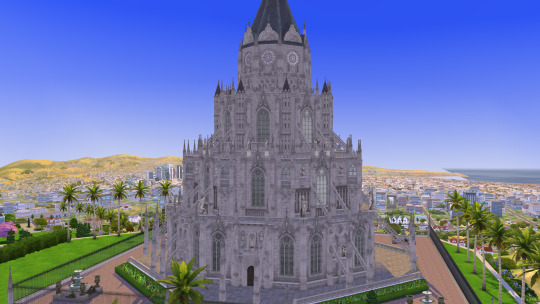
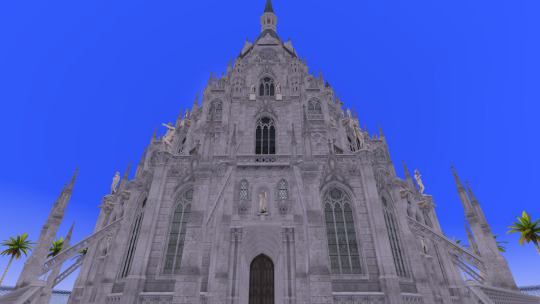
It is octagonal in shape and very formidable, it has four altars and four entrances. I am really proud of how it turned out as in the beginning it was much shorter and the objects on the diagonal sides weren’t very neat, but when I discovered the TOOL Mod, I was able to fix all of that. It is more monumental than Sainte Marguerite and has no divisions or rooms, only one, large hall that is the interior:
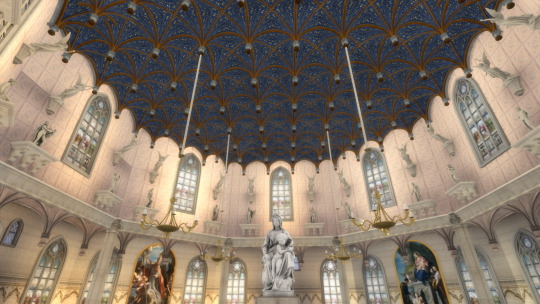

The exterior took the most work as the I finished the interior in 2 hours.
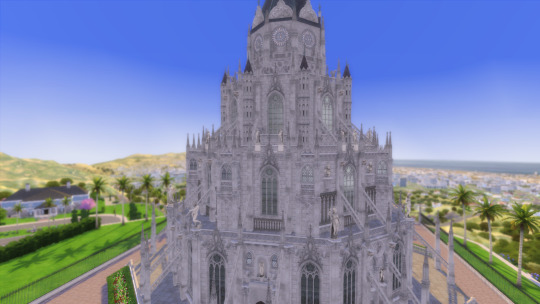
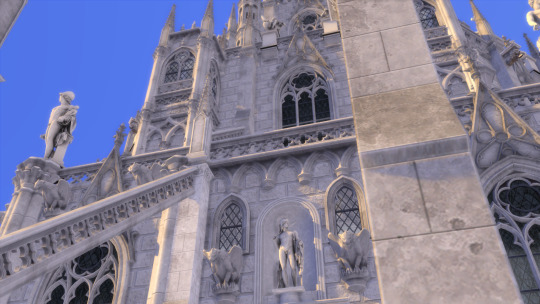
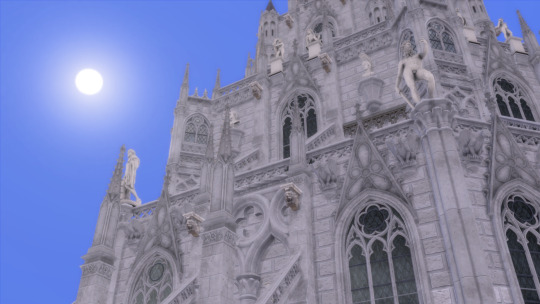
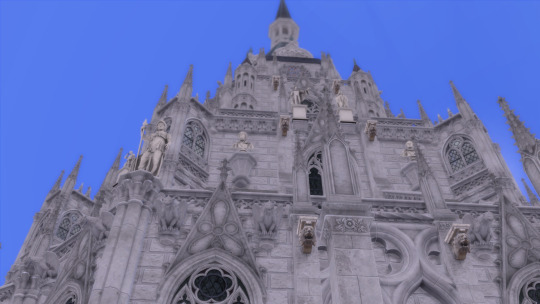
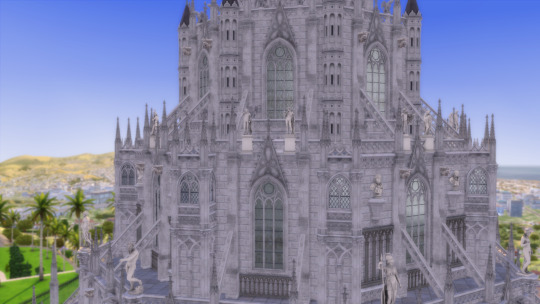
Download:
You can download this build in the Sims 4 Gallery my ID is AZIZSIMS
Mods list after the cut :)
CC List:
-Felixandre:
· Gothic Set
· Schwerin Set
· Versailles Set
· London Set
· Florence Set
· Berlin Set
· Kyoto Set (for the crosses)
-AggressiveKitty
· Medieval Set
· Cathedral Set
· Sliver Dining Set
· Brutalism Set (Used the blocks as floorings)
-TheJim07:
· All Statues
· All Busts
· Gothic Rose Window: https://modthesims.info/d/627132/gothic-rose-window.html
· Doric Pedestals: https://modthesims.info/d/651085/doric-columns-pilasters-and-pedestals.html
· Candelabra: https://thejim07.tumblr.com/post/620343624716189696/three-candelabra-from-dmc5-hi-everyone-these
· Imperial Candelabrum: https://modthesims.info/d/647004/imperial-candelabrum.html
· Citadel Marble Flooring: https://modthesims.info/d/646427/citadel-marble-flooring.html
· Ancient Transport Urn Sculpture: https://modthesims.info/d/595598/ancient-transport-urn-sculpture-from-ts2.html
· Greaves’ Ceiling Lights from TS3: https://modthesims.info/d/616108/greaves-ceiling-lights-from-ts3.html
· Monumental Vase: https://modthesims.info/d/648814/monumental-vase.html
· Lyon Fence: https://modthesims.info/d/646136/lyon-wrought-iron-fence.html
-ArtysSims:
· Baroque Altar: https://artyssims.tumblr.com/post/636493497965363200/baroque-altar-inspired-by-the-royal-chappel-at-the
· Piccolomini Library Set: https://artyssims.tumblr.com/post/638565283849781248/piccolomini-library-set-merry-christmas-a-bit
-The Regal Sim:
· Gothic Ceilings: https://regalsims.blogspot.com/2021/04/gothic-arched-pillar-set-for-ts4.html
-TheMarbleMortal:
· Venetian Tiles: https://themarblemortal.tumblr.com/post/633850359880826880/venetian-floors-galore-couldnt-find-any-nice
-Noir and Dark Sims 4
· Fountain: http://www.mediafire.com/file/5sah8431rulq7s9/%255BNoir_and_Dark_Sims_4%255D_Fallout_4_-_Fountain_and_Statues_Set.rar/file
-Networksmis:
· Euphoric Stone Walls: https://www.thesimsresource.com/themes/goth/downloads/details/category/sims4-walls/title/euphoric-stone-walls-networksims/id/1505381/
-Mara45123:
· Monastery Walls: http://mara45123sims.blogspot.com/2016/10/blog-post_22.html
Thanks:
I want to thank all the creators, some of them require payment (and there is nothing wrong with charging for your creations) and some of them provide CC for free but you can support them and here is how, if you can:
Requiring Payment:
Felixandre: https://www.patreon.com/felixandre
AggerssiveKitty: https://www.patreon.com/aggressivekitty
For Free, but support them if you can:
TheJim07: https://ko-fi.com/thejim07
TheMarbleMortal: https://www.patreon.com/themarblemortal
ArtysSims: https://ko-fi.com/artyssims
#the sims 4#the sims#builds#gothic#cathedral#gothic cathedral#builder#the sims 4 builder#the sims builder#build#the sims 4 build#the sims build#the sims 4 builds#the sims builds#cc#the sims 4 gallery#monument
62 notes
·
View notes
Photo

[Imperial Library of the Louvre], Edouard Baldus, 1856–57, Metropolitan Museum of Art: Photography
Purchase, The Horace W. Goldsmith Foundation Gift, through Joyce and Robert Menschel, 1994 Size: 43.9 x 34.2 cm. (17 1/4 x 13 7/16 in.) Medium: Salted paper print from glass negative
https://www.metmuseum.org/art/collection/search/267002
28 notes
·
View notes
Photo
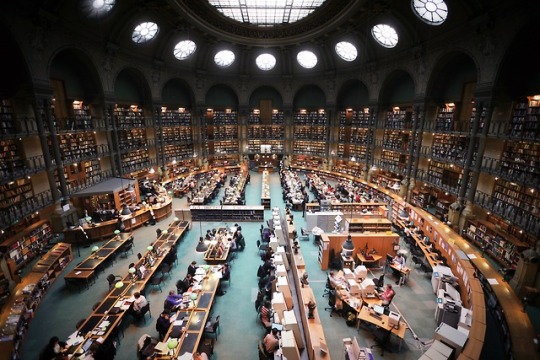
The Bibliothèque nationale de France is the national library of France, located in Paris. It is the national repository of all that is published in France and also holds extensive historical collections.
The National Library of France traces its origin to the royal library founded at the Louvre Palace by Charles V in 1368. Charles had received a collection of manuscripts from his predecessor, John II, and transferred them to the Louvre from the Palais de la Cité. The first librarian of record was Claude Mallet, the king's valet de chambre, who made a sort of catalogue, Inventoire des Livres du Roy nostre Seigneur estans au Chastel du Louvre. Jean Blanchet made another list in 1380 and Jean de Bégue one in 1411 and another in 1424. Charles V was a patron of learning and encouraged the making and collection of books. It is known that he employed Nicholas Oresme, Raoul de Presle and others to transcribe ancient texts. At the death of Charles VI, this first collection was unilaterally bought by the English regent of France, the Duke of Bedford, who transferred it to England in 1424. It was apparently dispersed at his death in 1435.
Charles VII did little to repair the loss of these books, but the invention of printing resulted in the starting of another collection in the Louvre inherited by Louis XI in 1461. Charles VIII seized a part of the collection of the kings of Aragon. Louis XII, who had inherited the library at Blois, incorporated the latter into the Bibliothèque du Roi and further enriched it with the Gruthuyse collection and with plunder from Milan. Francis I transferred the collection in 1534 to Fontainebleau and merged it with his private library. During his reign, fine bindings became the craze and many of the books added by him and Henry II are masterpieces of the binder's art.
Under librarianship of Amyot, the collection was transferred to Paris during which process many treasures were lost. Henry IV again moved it to the Collège de Clermont and in 1604 it was housed in the Rue de la Harpe. The appointment of Jacques Auguste de Thou as librarian initiated a period of development that made it the largest and richest collection of books in the world. He was succeeded by his son who was replaced, when executed for treason, by Jérôme Bignon, the first of a line of librarians of the same name. Under de Thou, the library was enriched by the collections of Queen Catherine de Medici. The library grew rapidly during the reigns of Louis XIII and Louis XIV, due in great part to the interest of the Minister of Finance, Colbert, an indefatigable collectors of books.
The quarters in the Rue de la Harpe becoming inadequate, the library was again moved, in 1666, to a more spacious house in Rue Vivienne. The minister Louvois took quite as much interest in the library as Colbert and during his administration a magnificent building to be erected in the Place Vendôme was planned. The death of Louvois, however, prevented the realization of this plan. Louvois employed Mabillon, Thévenot and others to procure books from every source. In 1688, a catalogue in eight volumes was compiled.
The library opened to the public in 1692, under the administration of Abbé Louvois, Minister Louvois's son. Abbé Louvois was succeeded by Jean-Paul Bignon, who instituted a complete reform of the library's system. Catalogues were made which appeared from 1739 to 1753 in 11 volumes. The collections increased steadily by purchase and gift to the outbreak of the French Revolution, at which time it was in grave danger of partial or total destruction, but owing to the activities of Antoine-Augustin Renouard and Joseph Van Praet it suffered no injury.
The library's collections swelled to over 300,000 volumes during the radical phase of the French Revolution when the private libraries of aristocrats and clergy were seized. After the establishment of the French First Republic in September 1792, "the Assembly declared the Bibliotheque du Roi to be national property and the institution was renamed the Bibliothèque Nationale. After four centuries of control by the Crown, this great library now became the property of the French people."
A new administrative organization was established. Napoleon took great interest in the library and among other things issued an order that all books in provincial libraries not possessed by the Bibliothèque Nationale should be forwarded to it, subject to replacement by exchanges of equal value from the duplicate collections, making it possible, as Napoleon said, to find a copy of any book in France in the National Library. Napoleon furthermore increased the collections by spoil from his conquests. A considerable number of these books was restored after his downfall. During the period from 1800 to 1836, the library was virtually under the control of Joseph Van Praet. At his death it contained more than 650,000 printed books and some 80,000 manuscripts.
Following a series of regime changes in France, it became the Imperial National Library and in 1868 was moved to newly constructed buildings on the Rue de Richelieu designed by Henri Labrouste. Upon Labrouste's death in 1875 the library was further expanded, including the grand staircase and the Oval Room, by academic architect Jean-Louis Pascal. In 1896, the library was still the largest repository of books in the world, although it has since been surpassed by other libraries for that title. By 1920, the library's collection had grown to 4,050,000 volumes and 11,000 manuscripts.
M. Henri Lemaître, a vice-president of the French Library Association and formerly librarian of the Bibliothèque Nationale ... outlined the story of French libraries and librarians during the German occupation, a record of destruction and racial discrimination. During 1940–1945, more than two million books were lost through the ravages of war, many of them forming the irreplaceable local collections in which France abounded. Many thousands of books, including complete libraries, were seized by the Germans. Yet French librarians stood firm against all threats, and continued to serve their readers to the best of their abilities. In their private lives and in their professional occupations they were in the van of the struggle against the Nazis, and many suffered imprisonment and death for their devotion. Despite Nazi opposition they maintained a supply of books to French prisoners of war. They continued to supply books on various proscribed lists to trustworthy readers; and when liberation came, they were ready with their plans for rehabilitation with the creation of new book centres for the French people on lines of the English county library system.
Daily inspiration. Discover more photos at http://justforbooks.tumblr.com
6 notes
·
View notes
Photo
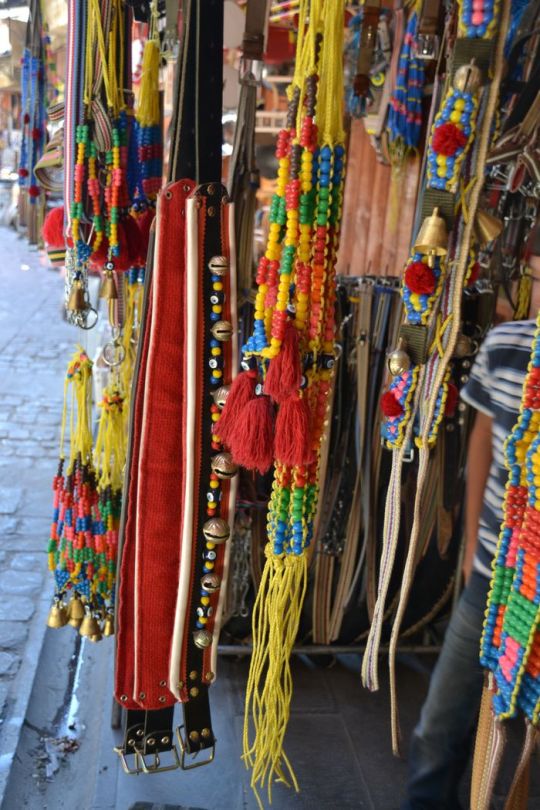
The Musie Dupuytren
This Conciergerie, with the hall of the Cordelier Club, the Musie Dupuytren, is the only extant building in Paris, which is closely associated with great scenes of the Revo-lution. The Bastille is gone, the Tuileries, the Hotel de Ville, the Hall of the Convention in the R. de Rivoli, the Jacobin Club, the prisons, the Temple, Abbaye, La Force, Chatelet, and the rest. So, too, the tombs of Mirabeau, Voltaire, Rousseau, Marat, Louis xvi., and Marie Antoinette no longer hold their bones, and cenotaphs record the spot where they were laid. Etiam periere sepulchra. New Haussmannic streets cover the soil, wherein the ashes of Danton and Vergniaud, Charlotte Corday and Madame Roland, moulder unknown. Of the Revolution no buildings remain but only sites; and the only edifices, which survive to speak to us of the September massacres and the Terror, are the dining-hall of the followers of St. Francis and the palace of St. Louis, the knight and crusader.
In spite of destruction and reconstruction, the history pf the great edifices of old Paris is wonderfully instructive, even that of the buildings which have wholly disappeared. But they must be studied in the learned and elaborate works, such as those of Dulaure, Piganiol, Viollet-le-Duc, Lacroix, Lenoir, Guilhermy, Fournier, Hoffbauer, Fergus- son, Hamerton, in the Histoire Generale, and in Paris a travers les Ages, in the splendid series of etchings and engravings of old Paris, which may be found in the library of the Carnavalet Museum, and in our British Museum. Bastille, Louvre, Hdtel de Ville, Tuileries, Luxembourg, the Citd, St. Germain, St. Genevilve, would each require an essay, or a volume with maps and plans and restorations, to make them intelligible private tours istanbul. But those who seek to know what Paris has been in the long succession of ages may still revive it in their minds, with the aid of the mass of literature that is open to them, and if they will study not only the extant churches, but such works of domestic art as the Hotel Cluny, and Hotel de Sens, Hotel la Valette, the house in the Corn’s la Reine, and the Hotel Carnavalet.
Ducerceau and M6ryon
A careful study of Silvestre, Ducerceau, and M6ryon will give some idea of old Paris, with its vast walls, gates, towers, castles, its crowded churches, its immense abbeys, its narrow winding streets, its fetid cemeteries, gloomy courts and impasses, its filthy lanes, and its bridges loaded with houses. We may linger about the old remnants of churches, the flotsam and jetsam of the Mediaeval Catholicism, such bits as the tower of St. Jacques, and the portals of the two St. Germains and of St. Nicolas des Champs, the old churches of St. Jnlien le Pauvre, and St. Martin des Champs, the church of St. Sdverin, and the chapel of the Chdteau de Vincennes.
Then let us study the tombs in St. Germain des Pris, of St. Denis, St. Etienne du Mont: and then we may go on to the tomb that all Englishmen visit — the tomb which I always feel to be the grandest of all sepulchral conceptions (to be set beside the tomb of Theod- oric at Ravenna, and the tomb of Cecilia Metella on the Appian way), almost the one work of modern art, which is at once colossal, noble, and pathetic — I mean the mighty vault beneath the dome of the Invalidcs, where the greatest soldier and the worst ruler of our age sleeps at last in peace, guarded by the veterans of France.
We need not deny to modern Paris the gift of charm; we may admit that her museums and libraries, her collections, and her treasures are inexhaustible to the fit student; but far more impressive is the history of this memorable city, with its vast range of time, of variety, of association — with its record of the dawn of Western civilisation, of Catholicism and Feudalism, of the Renascence, and the modern world, of the Revolution of the last century, and the Imperialism of this century — with its dust enriched with the bones of those who in things of the soul and in things of war, in the love of beauty, and in the passion for new life, have dared and done memorable deeds, from the days of Genevieve and Clotilda, the Louis and the Henrys, down to the two Napoleons, and the three Republics.
0 notes
Photo
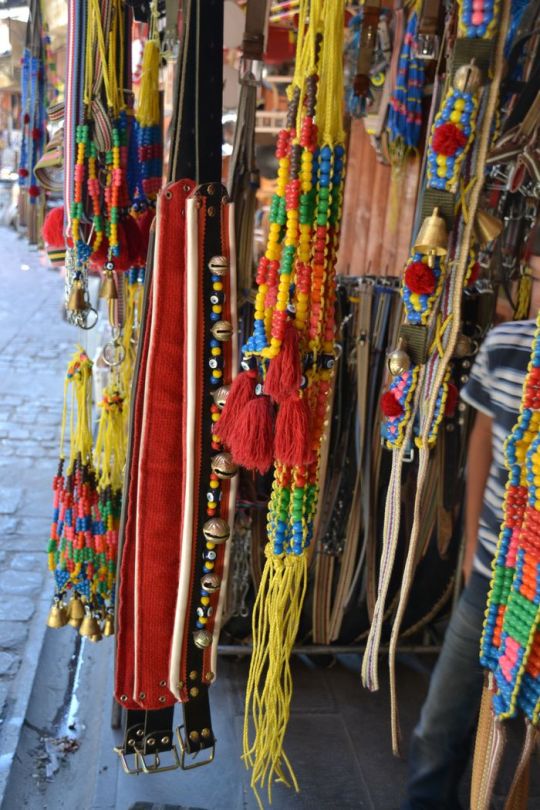
The Musie Dupuytren
This Conciergerie, with the hall of the Cordelier Club, the Musie Dupuytren, is the only extant building in Paris, which is closely associated with great scenes of the Revo-lution. The Bastille is gone, the Tuileries, the Hotel de Ville, the Hall of the Convention in the R. de Rivoli, the Jacobin Club, the prisons, the Temple, Abbaye, La Force, Chatelet, and the rest. So, too, the tombs of Mirabeau, Voltaire, Rousseau, Marat, Louis xvi., and Marie Antoinette no longer hold their bones, and cenotaphs record the spot where they were laid. Etiam periere sepulchra. New Haussmannic streets cover the soil, wherein the ashes of Danton and Vergniaud, Charlotte Corday and Madame Roland, moulder unknown. Of the Revolution no buildings remain but only sites; and the only edifices, which survive to speak to us of the September massacres and the Terror, are the dining-hall of the followers of St. Francis and the palace of St. Louis, the knight and crusader.
In spite of destruction and reconstruction, the history pf the great edifices of old Paris is wonderfully instructive, even that of the buildings which have wholly disappeared. But they must be studied in the learned and elaborate works, such as those of Dulaure, Piganiol, Viollet-le-Duc, Lacroix, Lenoir, Guilhermy, Fournier, Hoffbauer, Fergus- son, Hamerton, in the Histoire Generale, and in Paris a travers les Ages, in the splendid series of etchings and engravings of old Paris, which may be found in the library of the Carnavalet Museum, and in our British Museum. Bastille, Louvre, Hdtel de Ville, Tuileries, Luxembourg, the Citd, St. Germain, St. Genevilve, would each require an essay, or a volume with maps and plans and restorations, to make them intelligible private tours istanbul. But those who seek to know what Paris has been in the long succession of ages may still revive it in their minds, with the aid of the mass of literature that is open to them, and if they will study not only the extant churches, but such works of domestic art as the Hotel Cluny, and Hotel de Sens, Hotel la Valette, the house in the Corn’s la Reine, and the Hotel Carnavalet.
Ducerceau and M6ryon
A careful study of Silvestre, Ducerceau, and M6ryon will give some idea of old Paris, with its vast walls, gates, towers, castles, its crowded churches, its immense abbeys, its narrow winding streets, its fetid cemeteries, gloomy courts and impasses, its filthy lanes, and its bridges loaded with houses. We may linger about the old remnants of churches, the flotsam and jetsam of the Mediaeval Catholicism, such bits as the tower of St. Jacques, and the portals of the two St. Germains and of St. Nicolas des Champs, the old churches of St. Jnlien le Pauvre, and St. Martin des Champs, the church of St. Sdverin, and the chapel of the Chdteau de Vincennes.
Then let us study the tombs in St. Germain des Pris, of St. Denis, St. Etienne du Mont: and then we may go on to the tomb that all Englishmen visit — the tomb which I always feel to be the grandest of all sepulchral conceptions (to be set beside the tomb of Theod- oric at Ravenna, and the tomb of Cecilia Metella on the Appian way), almost the one work of modern art, which is at once colossal, noble, and pathetic — I mean the mighty vault beneath the dome of the Invalidcs, where the greatest soldier and the worst ruler of our age sleeps at last in peace, guarded by the veterans of France.
We need not deny to modern Paris the gift of charm; we may admit that her museums and libraries, her collections, and her treasures are inexhaustible to the fit student; but far more impressive is the history of this memorable city, with its vast range of time, of variety, of association — with its record of the dawn of Western civilisation, of Catholicism and Feudalism, of the Renascence, and the modern world, of the Revolution of the last century, and the Imperialism of this century — with its dust enriched with the bones of those who in things of the soul and in things of war, in the love of beauty, and in the passion for new life, have dared and done memorable deeds, from the days of Genevieve and Clotilda, the Louis and the Henrys, down to the two Napoleons, and the three Republics.
0 notes
Photo
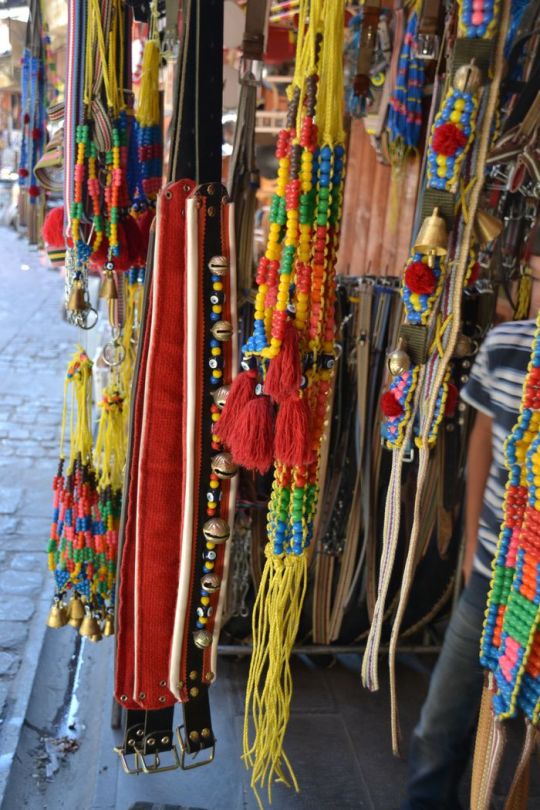
The Musie Dupuytren
This Conciergerie, with the hall of the Cordelier Club, the Musie Dupuytren, is the only extant building in Paris, which is closely associated with great scenes of the Revo-lution. The Bastille is gone, the Tuileries, the Hotel de Ville, the Hall of the Convention in the R. de Rivoli, the Jacobin Club, the prisons, the Temple, Abbaye, La Force, Chatelet, and the rest. So, too, the tombs of Mirabeau, Voltaire, Rousseau, Marat, Louis xvi., and Marie Antoinette no longer hold their bones, and cenotaphs record the spot where they were laid. Etiam periere sepulchra. New Haussmannic streets cover the soil, wherein the ashes of Danton and Vergniaud, Charlotte Corday and Madame Roland, moulder unknown. Of the Revolution no buildings remain but only sites; and the only edifices, which survive to speak to us of the September massacres and the Terror, are the dining-hall of the followers of St. Francis and the palace of St. Louis, the knight and crusader.
In spite of destruction and reconstruction, the history pf the great edifices of old Paris is wonderfully instructive, even that of the buildings which have wholly disappeared. But they must be studied in the learned and elaborate works, such as those of Dulaure, Piganiol, Viollet-le-Duc, Lacroix, Lenoir, Guilhermy, Fournier, Hoffbauer, Fergus- son, Hamerton, in the Histoire Generale, and in Paris a travers les Ages, in the splendid series of etchings and engravings of old Paris, which may be found in the library of the Carnavalet Museum, and in our British Museum. Bastille, Louvre, Hdtel de Ville, Tuileries, Luxembourg, the Citd, St. Germain, St. Genevilve, would each require an essay, or a volume with maps and plans and restorations, to make them intelligible private tours istanbul. But those who seek to know what Paris has been in the long succession of ages may still revive it in their minds, with the aid of the mass of literature that is open to them, and if they will study not only the extant churches, but such works of domestic art as the Hotel Cluny, and Hotel de Sens, Hotel la Valette, the house in the Corn’s la Reine, and the Hotel Carnavalet.
Ducerceau and M6ryon
A careful study of Silvestre, Ducerceau, and M6ryon will give some idea of old Paris, with its vast walls, gates, towers, castles, its crowded churches, its immense abbeys, its narrow winding streets, its fetid cemeteries, gloomy courts and impasses, its filthy lanes, and its bridges loaded with houses. We may linger about the old remnants of churches, the flotsam and jetsam of the Mediaeval Catholicism, such bits as the tower of St. Jacques, and the portals of the two St. Germains and of St. Nicolas des Champs, the old churches of St. Jnlien le Pauvre, and St. Martin des Champs, the church of St. Sdverin, and the chapel of the Chdteau de Vincennes.
Then let us study the tombs in St. Germain des Pris, of St. Denis, St. Etienne du Mont: and then we may go on to the tomb that all Englishmen visit — the tomb which I always feel to be the grandest of all sepulchral conceptions (to be set beside the tomb of Theod- oric at Ravenna, and the tomb of Cecilia Metella on the Appian way), almost the one work of modern art, which is at once colossal, noble, and pathetic — I mean the mighty vault beneath the dome of the Invalidcs, where the greatest soldier and the worst ruler of our age sleeps at last in peace, guarded by the veterans of France.
We need not deny to modern Paris the gift of charm; we may admit that her museums and libraries, her collections, and her treasures are inexhaustible to the fit student; but far more impressive is the history of this memorable city, with its vast range of time, of variety, of association — with its record of the dawn of Western civilisation, of Catholicism and Feudalism, of the Renascence, and the modern world, of the Revolution of the last century, and the Imperialism of this century — with its dust enriched with the bones of those who in things of the soul and in things of war, in the love of beauty, and in the passion for new life, have dared and done memorable deeds, from the days of Genevieve and Clotilda, the Louis and the Henrys, down to the two Napoleons, and the three Republics.
0 notes
Photo
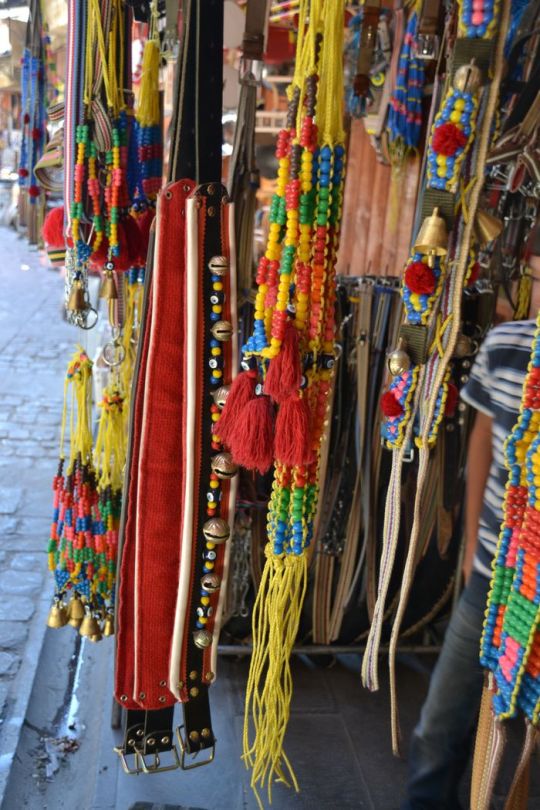
The Musie Dupuytren
This Conciergerie, with the hall of the Cordelier Club, the Musie Dupuytren, is the only extant building in Paris, which is closely associated with great scenes of the Revo-lution. The Bastille is gone, the Tuileries, the Hotel de Ville, the Hall of the Convention in the R. de Rivoli, the Jacobin Club, the prisons, the Temple, Abbaye, La Force, Chatelet, and the rest. So, too, the tombs of Mirabeau, Voltaire, Rousseau, Marat, Louis xvi., and Marie Antoinette no longer hold their bones, and cenotaphs record the spot where they were laid. Etiam periere sepulchra. New Haussmannic streets cover the soil, wherein the ashes of Danton and Vergniaud, Charlotte Corday and Madame Roland, moulder unknown. Of the Revolution no buildings remain but only sites; and the only edifices, which survive to speak to us of the September massacres and the Terror, are the dining-hall of the followers of St. Francis and the palace of St. Louis, the knight and crusader.
In spite of destruction and reconstruction, the history pf the great edifices of old Paris is wonderfully instructive, even that of the buildings which have wholly disappeared. But they must be studied in the learned and elaborate works, such as those of Dulaure, Piganiol, Viollet-le-Duc, Lacroix, Lenoir, Guilhermy, Fournier, Hoffbauer, Fergus- son, Hamerton, in the Histoire Generale, and in Paris a travers les Ages, in the splendid series of etchings and engravings of old Paris, which may be found in the library of the Carnavalet Museum, and in our British Museum. Bastille, Louvre, Hdtel de Ville, Tuileries, Luxembourg, the Citd, St. Germain, St. Genevilve, would each require an essay, or a volume with maps and plans and restorations, to make them intelligible private tours istanbul. But those who seek to know what Paris has been in the long succession of ages may still revive it in their minds, with the aid of the mass of literature that is open to them, and if they will study not only the extant churches, but such works of domestic art as the Hotel Cluny, and Hotel de Sens, Hotel la Valette, the house in the Corn’s la Reine, and the Hotel Carnavalet.
Ducerceau and M6ryon
A careful study of Silvestre, Ducerceau, and M6ryon will give some idea of old Paris, with its vast walls, gates, towers, castles, its crowded churches, its immense abbeys, its narrow winding streets, its fetid cemeteries, gloomy courts and impasses, its filthy lanes, and its bridges loaded with houses. We may linger about the old remnants of churches, the flotsam and jetsam of the Mediaeval Catholicism, such bits as the tower of St. Jacques, and the portals of the two St. Germains and of St. Nicolas des Champs, the old churches of St. Jnlien le Pauvre, and St. Martin des Champs, the church of St. Sdverin, and the chapel of the Chdteau de Vincennes.
Then let us study the tombs in St. Germain des Pris, of St. Denis, St. Etienne du Mont: and then we may go on to the tomb that all Englishmen visit — the tomb which I always feel to be the grandest of all sepulchral conceptions (to be set beside the tomb of Theod- oric at Ravenna, and the tomb of Cecilia Metella on the Appian way), almost the one work of modern art, which is at once colossal, noble, and pathetic — I mean the mighty vault beneath the dome of the Invalidcs, where the greatest soldier and the worst ruler of our age sleeps at last in peace, guarded by the veterans of France.
We need not deny to modern Paris the gift of charm; we may admit that her museums and libraries, her collections, and her treasures are inexhaustible to the fit student; but far more impressive is the history of this memorable city, with its vast range of time, of variety, of association — with its record of the dawn of Western civilisation, of Catholicism and Feudalism, of the Renascence, and the modern world, of the Revolution of the last century, and the Imperialism of this century — with its dust enriched with the bones of those who in things of the soul and in things of war, in the love of beauty, and in the passion for new life, have dared and done memorable deeds, from the days of Genevieve and Clotilda, the Louis and the Henrys, down to the two Napoleons, and the three Republics.
0 notes
Photo

The Musie Dupuytren
This Conciergerie, with the hall of the Cordelier Club, the Musie Dupuytren, is the only extant building in Paris, which is closely associated with great scenes of the Revo-lution. The Bastille is gone, the Tuileries, the Hotel de Ville, the Hall of the Convention in the R. de Rivoli, the Jacobin Club, the prisons, the Temple, Abbaye, La Force, Chatelet, and the rest. So, too, the tombs of Mirabeau, Voltaire, Rousseau, Marat, Louis xvi., and Marie Antoinette no longer hold their bones, and cenotaphs record the spot where they were laid. Etiam periere sepulchra. New Haussmannic streets cover the soil, wherein the ashes of Danton and Vergniaud, Charlotte Corday and Madame Roland, moulder unknown. Of the Revolution no buildings remain but only sites; and the only edifices, which survive to speak to us of the September massacres and the Terror, are the dining-hall of the followers of St. Francis and the palace of St. Louis, the knight and crusader.
In spite of destruction and reconstruction, the history pf the great edifices of old Paris is wonderfully instructive, even that of the buildings which have wholly disappeared. But they must be studied in the learned and elaborate works, such as those of Dulaure, Piganiol, Viollet-le-Duc, Lacroix, Lenoir, Guilhermy, Fournier, Hoffbauer, Fergus- son, Hamerton, in the Histoire Generale, and in Paris a travers les Ages, in the splendid series of etchings and engravings of old Paris, which may be found in the library of the Carnavalet Museum, and in our British Museum. Bastille, Louvre, Hdtel de Ville, Tuileries, Luxembourg, the Citd, St. Germain, St. Genevilve, would each require an essay, or a volume with maps and plans and restorations, to make them intelligible private tours istanbul. But those who seek to know what Paris has been in the long succession of ages may still revive it in their minds, with the aid of the mass of literature that is open to them, and if they will study not only the extant churches, but such works of domestic art as the Hotel Cluny, and Hotel de Sens, Hotel la Valette, the house in the Corn’s la Reine, and the Hotel Carnavalet.
Ducerceau and M6ryon
A careful study of Silvestre, Ducerceau, and M6ryon will give some idea of old Paris, with its vast walls, gates, towers, castles, its crowded churches, its immense abbeys, its narrow winding streets, its fetid cemeteries, gloomy courts and impasses, its filthy lanes, and its bridges loaded with houses. We may linger about the old remnants of churches, the flotsam and jetsam of the Mediaeval Catholicism, such bits as the tower of St. Jacques, and the portals of the two St. Germains and of St. Nicolas des Champs, the old churches of St. Jnlien le Pauvre, and St. Martin des Champs, the church of St. Sdverin, and the chapel of the Chdteau de Vincennes.
Then let us study the tombs in St. Germain des Pris, of St. Denis, St. Etienne du Mont: and then we may go on to the tomb that all Englishmen visit — the tomb which I always feel to be the grandest of all sepulchral conceptions (to be set beside the tomb of Theod- oric at Ravenna, and the tomb of Cecilia Metella on the Appian way), almost the one work of modern art, which is at once colossal, noble, and pathetic — I mean the mighty vault beneath the dome of the Invalidcs, where the greatest soldier and the worst ruler of our age sleeps at last in peace, guarded by the veterans of France.
We need not deny to modern Paris the gift of charm; we may admit that her museums and libraries, her collections, and her treasures are inexhaustible to the fit student; but far more impressive is the history of this memorable city, with its vast range of time, of variety, of association — with its record of the dawn of Western civilisation, of Catholicism and Feudalism, of the Renascence, and the modern world, of the Revolution of the last century, and the Imperialism of this century — with its dust enriched with the bones of those who in things of the soul and in things of war, in the love of beauty, and in the passion for new life, have dared and done memorable deeds, from the days of Genevieve and Clotilda, the Louis and the Henrys, down to the two Napoleons, and the three Republics.
0 notes
Photo

The Musie Dupuytren
This Conciergerie, with the hall of the Cordelier Club, the Musie Dupuytren, is the only extant building in Paris, which is closely associated with great scenes of the Revo-lution. The Bastille is gone, the Tuileries, the Hotel de Ville, the Hall of the Convention in the R. de Rivoli, the Jacobin Club, the prisons, the Temple, Abbaye, La Force, Chatelet, and the rest. So, too, the tombs of Mirabeau, Voltaire, Rousseau, Marat, Louis xvi., and Marie Antoinette no longer hold their bones, and cenotaphs record the spot where they were laid. Etiam periere sepulchra. New Haussmannic streets cover the soil, wherein the ashes of Danton and Vergniaud, Charlotte Corday and Madame Roland, moulder unknown. Of the Revolution no buildings remain but only sites; and the only edifices, which survive to speak to us of the September massacres and the Terror, are the dining-hall of the followers of St. Francis and the palace of St. Louis, the knight and crusader.
In spite of destruction and reconstruction, the history pf the great edifices of old Paris is wonderfully instructive, even that of the buildings which have wholly disappeared. But they must be studied in the learned and elaborate works, such as those of Dulaure, Piganiol, Viollet-le-Duc, Lacroix, Lenoir, Guilhermy, Fournier, Hoffbauer, Fergus- son, Hamerton, in the Histoire Generale, and in Paris a travers les Ages, in the splendid series of etchings and engravings of old Paris, which may be found in the library of the Carnavalet Museum, and in our British Museum. Bastille, Louvre, Hdtel de Ville, Tuileries, Luxembourg, the Citd, St. Germain, St. Genevilve, would each require an essay, or a volume with maps and plans and restorations, to make them intelligible private tours istanbul. But those who seek to know what Paris has been in the long succession of ages may still revive it in their minds, with the aid of the mass of literature that is open to them, and if they will study not only the extant churches, but such works of domestic art as the Hotel Cluny, and Hotel de Sens, Hotel la Valette, the house in the Corn’s la Reine, and the Hotel Carnavalet.
Ducerceau and M6ryon
A careful study of Silvestre, Ducerceau, and M6ryon will give some idea of old Paris, with its vast walls, gates, towers, castles, its crowded churches, its immense abbeys, its narrow winding streets, its fetid cemeteries, gloomy courts and impasses, its filthy lanes, and its bridges loaded with houses. We may linger about the old remnants of churches, the flotsam and jetsam of the Mediaeval Catholicism, such bits as the tower of St. Jacques, and the portals of the two St. Germains and of St. Nicolas des Champs, the old churches of St. Jnlien le Pauvre, and St. Martin des Champs, the church of St. Sdverin, and the chapel of the Chdteau de Vincennes.
Then let us study the tombs in St. Germain des Pris, of St. Denis, St. Etienne du Mont: and then we may go on to the tomb that all Englishmen visit — the tomb which I always feel to be the grandest of all sepulchral conceptions (to be set beside the tomb of Theod- oric at Ravenna, and the tomb of Cecilia Metella on the Appian way), almost the one work of modern art, which is at once colossal, noble, and pathetic — I mean the mighty vault beneath the dome of the Invalidcs, where the greatest soldier and the worst ruler of our age sleeps at last in peace, guarded by the veterans of France.
We need not deny to modern Paris the gift of charm; we may admit that her museums and libraries, her collections, and her treasures are inexhaustible to the fit student; but far more impressive is the history of this memorable city, with its vast range of time, of variety, of association — with its record of the dawn of Western civilisation, of Catholicism and Feudalism, of the Renascence, and the modern world, of the Revolution of the last century, and the Imperialism of this century — with its dust enriched with the bones of those who in things of the soul and in things of war, in the love of beauty, and in the passion for new life, have dared and done memorable deeds, from the days of Genevieve and Clotilda, the Louis and the Henrys, down to the two Napoleons, and the three Republics.
0 notes
Photo

The Musie Dupuytren
This Conciergerie, with the hall of the Cordelier Club, the Musie Dupuytren, is the only extant building in Paris, which is closely associated with great scenes of the Revo-lution. The Bastille is gone, the Tuileries, the Hotel de Ville, the Hall of the Convention in the R. de Rivoli, the Jacobin Club, the prisons, the Temple, Abbaye, La Force, Chatelet, and the rest. So, too, the tombs of Mirabeau, Voltaire, Rousseau, Marat, Louis xvi., and Marie Antoinette no longer hold their bones, and cenotaphs record the spot where they were laid. Etiam periere sepulchra. New Haussmannic streets cover the soil, wherein the ashes of Danton and Vergniaud, Charlotte Corday and Madame Roland, moulder unknown. Of the Revolution no buildings remain but only sites; and the only edifices, which survive to speak to us of the September massacres and the Terror, are the dining-hall of the followers of St. Francis and the palace of St. Louis, the knight and crusader.
In spite of destruction and reconstruction, the history pf the great edifices of old Paris is wonderfully instructive, even that of the buildings which have wholly disappeared. But they must be studied in the learned and elaborate works, such as those of Dulaure, Piganiol, Viollet-le-Duc, Lacroix, Lenoir, Guilhermy, Fournier, Hoffbauer, Fergus- son, Hamerton, in the Histoire Generale, and in Paris a travers les Ages, in the splendid series of etchings and engravings of old Paris, which may be found in the library of the Carnavalet Museum, and in our British Museum. Bastille, Louvre, Hdtel de Ville, Tuileries, Luxembourg, the Citd, St. Germain, St. Genevilve, would each require an essay, or a volume with maps and plans and restorations, to make them intelligible private tours istanbul. But those who seek to know what Paris has been in the long succession of ages may still revive it in their minds, with the aid of the mass of literature that is open to them, and if they will study not only the extant churches, but such works of domestic art as the Hotel Cluny, and Hotel de Sens, Hotel la Valette, the house in the Corn’s la Reine, and the Hotel Carnavalet.
Ducerceau and M6ryon
A careful study of Silvestre, Ducerceau, and M6ryon will give some idea of old Paris, with its vast walls, gates, towers, castles, its crowded churches, its immense abbeys, its narrow winding streets, its fetid cemeteries, gloomy courts and impasses, its filthy lanes, and its bridges loaded with houses. We may linger about the old remnants of churches, the flotsam and jetsam of the Mediaeval Catholicism, such bits as the tower of St. Jacques, and the portals of the two St. Germains and of St. Nicolas des Champs, the old churches of St. Jnlien le Pauvre, and St. Martin des Champs, the church of St. Sdverin, and the chapel of the Chdteau de Vincennes.
Then let us study the tombs in St. Germain des Pris, of St. Denis, St. Etienne du Mont: and then we may go on to the tomb that all Englishmen visit — the tomb which I always feel to be the grandest of all sepulchral conceptions (to be set beside the tomb of Theod- oric at Ravenna, and the tomb of Cecilia Metella on the Appian way), almost the one work of modern art, which is at once colossal, noble, and pathetic — I mean the mighty vault beneath the dome of the Invalidcs, where the greatest soldier and the worst ruler of our age sleeps at last in peace, guarded by the veterans of France.
We need not deny to modern Paris the gift of charm; we may admit that her museums and libraries, her collections, and her treasures are inexhaustible to the fit student; but far more impressive is the history of this memorable city, with its vast range of time, of variety, of association — with its record of the dawn of Western civilisation, of Catholicism and Feudalism, of the Renascence, and the modern world, of the Revolution of the last century, and the Imperialism of this century — with its dust enriched with the bones of those who in things of the soul and in things of war, in the love of beauty, and in the passion for new life, have dared and done memorable deeds, from the days of Genevieve and Clotilda, the Louis and the Henrys, down to the two Napoleons, and the three Republics.
0 notes
Photo

The Musie Dupuytren
This Conciergerie, with the hall of the Cordelier Club, the Musie Dupuytren, is the only extant building in Paris, which is closely associated with great scenes of the Revo-lution. The Bastille is gone, the Tuileries, the Hotel de Ville, the Hall of the Convention in the R. de Rivoli, the Jacobin Club, the prisons, the Temple, Abbaye, La Force, Chatelet, and the rest. So, too, the tombs of Mirabeau, Voltaire, Rousseau, Marat, Louis xvi., and Marie Antoinette no longer hold their bones, and cenotaphs record the spot where they were laid. Etiam periere sepulchra. New Haussmannic streets cover the soil, wherein the ashes of Danton and Vergniaud, Charlotte Corday and Madame Roland, moulder unknown. Of the Revolution no buildings remain but only sites; and the only edifices, which survive to speak to us of the September massacres and the Terror, are the dining-hall of the followers of St. Francis and the palace of St. Louis, the knight and crusader.
In spite of destruction and reconstruction, the history pf the great edifices of old Paris is wonderfully instructive, even that of the buildings which have wholly disappeared. But they must be studied in the learned and elaborate works, such as those of Dulaure, Piganiol, Viollet-le-Duc, Lacroix, Lenoir, Guilhermy, Fournier, Hoffbauer, Fergus- son, Hamerton, in the Histoire Generale, and in Paris a travers les Ages, in the splendid series of etchings and engravings of old Paris, which may be found in the library of the Carnavalet Museum, and in our British Museum. Bastille, Louvre, Hdtel de Ville, Tuileries, Luxembourg, the Citd, St. Germain, St. Genevilve, would each require an essay, or a volume with maps and plans and restorations, to make them intelligible private tours istanbul. But those who seek to know what Paris has been in the long succession of ages may still revive it in their minds, with the aid of the mass of literature that is open to them, and if they will study not only the extant churches, but such works of domestic art as the Hotel Cluny, and Hotel de Sens, Hotel la Valette, the house in the Corn’s la Reine, and the Hotel Carnavalet.
Ducerceau and M6ryon
A careful study of Silvestre, Ducerceau, and M6ryon will give some idea of old Paris, with its vast walls, gates, towers, castles, its crowded churches, its immense abbeys, its narrow winding streets, its fetid cemeteries, gloomy courts and impasses, its filthy lanes, and its bridges loaded with houses. We may linger about the old remnants of churches, the flotsam and jetsam of the Mediaeval Catholicism, such bits as the tower of St. Jacques, and the portals of the two St. Germains and of St. Nicolas des Champs, the old churches of St. Jnlien le Pauvre, and St. Martin des Champs, the church of St. Sdverin, and the chapel of the Chdteau de Vincennes.
Then let us study the tombs in St. Germain des Pris, of St. Denis, St. Etienne du Mont: and then we may go on to the tomb that all Englishmen visit — the tomb which I always feel to be the grandest of all sepulchral conceptions (to be set beside the tomb of Theod- oric at Ravenna, and the tomb of Cecilia Metella on the Appian way), almost the one work of modern art, which is at once colossal, noble, and pathetic — I mean the mighty vault beneath the dome of the Invalidcs, where the greatest soldier and the worst ruler of our age sleeps at last in peace, guarded by the veterans of France.
We need not deny to modern Paris the gift of charm; we may admit that her museums and libraries, her collections, and her treasures are inexhaustible to the fit student; but far more impressive is the history of this memorable city, with its vast range of time, of variety, of association — with its record of the dawn of Western civilisation, of Catholicism and Feudalism, of the Renascence, and the modern world, of the Revolution of the last century, and the Imperialism of this century — with its dust enriched with the bones of those who in things of the soul and in things of war, in the love of beauty, and in the passion for new life, have dared and done memorable deeds, from the days of Genevieve and Clotilda, the Louis and the Henrys, down to the two Napoleons, and the three Republics.
0 notes
Photo

The Musie Dupuytren
This Conciergerie, with the hall of the Cordelier Club, the Musie Dupuytren, is the only extant building in Paris, which is closely associated with great scenes of the Revo-lution. The Bastille is gone, the Tuileries, the Hotel de Ville, the Hall of the Convention in the R. de Rivoli, the Jacobin Club, the prisons, the Temple, Abbaye, La Force, Chatelet, and the rest. So, too, the tombs of Mirabeau, Voltaire, Rousseau, Marat, Louis xvi., and Marie Antoinette no longer hold their bones, and cenotaphs record the spot where they were laid. Etiam periere sepulchra. New Haussmannic streets cover the soil, wherein the ashes of Danton and Vergniaud, Charlotte Corday and Madame Roland, moulder unknown. Of the Revolution no buildings remain but only sites; and the only edifices, which survive to speak to us of the September massacres and the Terror, are the dining-hall of the followers of St. Francis and the palace of St. Louis, the knight and crusader.
In spite of destruction and reconstruction, the history pf the great edifices of old Paris is wonderfully instructive, even that of the buildings which have wholly disappeared. But they must be studied in the learned and elaborate works, such as those of Dulaure, Piganiol, Viollet-le-Duc, Lacroix, Lenoir, Guilhermy, Fournier, Hoffbauer, Fergus- son, Hamerton, in the Histoire Generale, and in Paris a travers les Ages, in the splendid series of etchings and engravings of old Paris, which may be found in the library of the Carnavalet Museum, and in our British Museum. Bastille, Louvre, Hdtel de Ville, Tuileries, Luxembourg, the Citd, St. Germain, St. Genevilve, would each require an essay, or a volume with maps and plans and restorations, to make them intelligible private tours istanbul. But those who seek to know what Paris has been in the long succession of ages may still revive it in their minds, with the aid of the mass of literature that is open to them, and if they will study not only the extant churches, but such works of domestic art as the Hotel Cluny, and Hotel de Sens, Hotel la Valette, the house in the Corn’s la Reine, and the Hotel Carnavalet.
Ducerceau and M6ryon
A careful study of Silvestre, Ducerceau, and M6ryon will give some idea of old Paris, with its vast walls, gates, towers, castles, its crowded churches, its immense abbeys, its narrow winding streets, its fetid cemeteries, gloomy courts and impasses, its filthy lanes, and its bridges loaded with houses. We may linger about the old remnants of churches, the flotsam and jetsam of the Mediaeval Catholicism, such bits as the tower of St. Jacques, and the portals of the two St. Germains and of St. Nicolas des Champs, the old churches of St. Jnlien le Pauvre, and St. Martin des Champs, the church of St. Sdverin, and the chapel of the Chdteau de Vincennes.
Then let us study the tombs in St. Germain des Pris, of St. Denis, St. Etienne du Mont: and then we may go on to the tomb that all Englishmen visit — the tomb which I always feel to be the grandest of all sepulchral conceptions (to be set beside the tomb of Theod- oric at Ravenna, and the tomb of Cecilia Metella on the Appian way), almost the one work of modern art, which is at once colossal, noble, and pathetic — I mean the mighty vault beneath the dome of the Invalidcs, where the greatest soldier and the worst ruler of our age sleeps at last in peace, guarded by the veterans of France.
We need not deny to modern Paris the gift of charm; we may admit that her museums and libraries, her collections, and her treasures are inexhaustible to the fit student; but far more impressive is the history of this memorable city, with its vast range of time, of variety, of association — with its record of the dawn of Western civilisation, of Catholicism and Feudalism, of the Renascence, and the modern world, of the Revolution of the last century, and the Imperialism of this century — with its dust enriched with the bones of those who in things of the soul and in things of war, in the love of beauty, and in the passion for new life, have dared and done memorable deeds, from the days of Genevieve and Clotilda, the Louis and the Henrys, down to the two Napoleons, and the three Republics.
0 notes